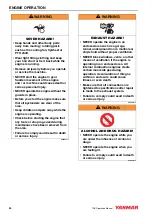
BEFORE YOU OPERATE
38
TNV Operation Manual
ENGINE OIL
Engine Oil Specifications
Use an engine oil that meets or exceeds the
following guidelines and classifications:
Service Categories
• API Service Categories CD or higher
• ACEA Service Categories E-3, E-4, and E-5
• JASO Service Category DH-1
Definitions
• API Classification (American Petroleum
Institute)
• ACEA Classification (Association des
Constructeurs Européens d’Automobilies)
• JASO (Japanese Automobile Standards
Organization)
Notes:
1. Be sure the engine oil, engine oil storage
containers, and engine oil filling equipment
are free of sediments and water.
2. Change the engine oil after the first 50
hours of operation and then at every 250
hours thereafter.
3. Select the oil viscosity based on the
ambient temperature where the engine is
being operated. See the SAE Service
Grade Viscosity Chart
(Figure 3)
.
4. Yanmar does not recommend the use of
engine oil “additives.”
Additional Technical Engine Oil
Requirements:
The engine oil must be changed when the Total
Base Number (TBN) has been reduced to 2.0.
TBN (mgKOH/g) test method; JIS K-201-5.2-2
(HCI), ASTM D4739 (HCI).
Engine Oil Viscosity
Select the appropriate engine oil viscosity based
on the ambient temperature and use the SAE
Service Grade Viscosity Chart in
Figure 3
.
Figure 3
Checking Engine Oil
1. Make sure engine is level.
2. Remove dipstick
(Figure 4, (1))
and wipe with
clean cloth.
3. Fully reinsert dipstick.
4. Remove dipstick. The oil level should be
between upper
(Figure 4, (2))
and lower
(Figure 4, (3))
lines on the dipstick.
5. Fully reinsert dipstick.
CAUTION
0000005en
• Only use the engine oil specified.
Other engine oils may affect warranty
coverage, cause internal engine
components to seize, or shorten
engine life.
• Prevent dirt and debris from
contaminating engine oil. Carefully
clean the oil cap / dipstick and the
surrounding area before you remove
the cap.
• NEVER mix different types of engine
oil. This may adversely affect the
lubricating properties of the engine oil.
• NEVER overfill. Overfilling may result
in white exhaust smoke, engine
overspeed or internal damage.
-4˚F 14˚F 32˚F
50˚F 6
8
˚F
8
6˚F 104˚F
(-20˚C) (-10˚C) (0˚C) (10˚C) (20˚C) (30˚C) (40˚C)
SAE 10W
SAE 20W
SAE 10W-30
SAE 15W-40
SAE 20
SAE 30
SAE 40
0000005
Содержание 2TNV70
Страница 1: ......
Страница 2: ......
Страница 32: ...SAFETY 14 TNV Operation Manual ...
Страница 116: ...PERIODIC MAINTENANCE 98 TNV Operation Manual ...
Страница 140: ...SPECIFICATIONS 122 TNV Operation Manual ...
Страница 141: ......
Страница 142: ......






























